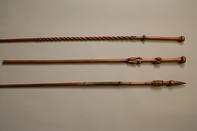
In the nineteenth century, rhino horn staffs were regarded as prestige items among communities from present-day Botswana, Lesotho and South Africa. Among the Ndebele, for example, rhinoceros-horn clubs were an essential part of the chief's regalia, functioning both as a staff of office and a symbol of personal dignity.
In 1844 the Scottish big-game hunter, Roualeyn Gordon-Cumming, obtained a long rhino horn staff in exchange for a cup of gunpowder from Chief Sekgoma, the leader of the Bamangwato chiefdom. He later described it as “a most wonderful knobkerrie made from a very rare species of the rhinoceros... its chief interest consist(ing) in its extraordinary length, which greatly exceeded anything I had ever seen of the kind before, or have since met with.”
Since even in the nineteenth century rhinoceroses with exceptionally long horns were rare, there was a direct link between the prestige value of these staffs and their length.

While working as a missionary in the Zulu kingdom, Gardiner made a composite sketch of King Dingane wearing beaded finery and an imported cloak. In the sketch on the right the king is holding a prestigious rhino horn staff.
On the left he is leaning on a brass pole that was probably given to him by one of the British traders who visited his at his royal homestead, Mngungundhlovu, or sent him presents, such as the upholstered chair he received from Benjamin Norden of the firm Maynard and Norden of Grahamstown in 1836. In the course of the 19th century, colonial officials also began to present African chiefs with short brass tipped staffs, a practice that was still prevalent when the Prince of Wales visited the continent in 1925.

The delicate articulation of form in examples like this staff suggests that it was made by an experienced artist who took great pride in producing staffs with elegantly balanced shafts. Usually carried singly, the latter were known among the Zulu as an isagila somnumzane and, if exceptionally long, it was referred to as an unhlongweni or udlewedlewe. In most cases, these chiefly staffs of office were surmounted by elaborately carved and decorated heads.

In the Zulu kingdom, the staffs of important dignitaries were usually made from hard woods like red ironwood and stinkwood. More commonly, chiefs and kings differentiated themselves from their subjects by carrying beautifully decorated staffs with unusually long shafts.
Staffs like these drew attention to the owner by being visible above the heads of people gathered together on festive and other occasions. Because snakes had links in indigenous cosmologies to the ancestral and spirit world, their presence on some of these staffs would have point to the strength and power of their owners.

Prestige staffs that were carved to look like spears were presumably intended to signal the powers vested in chiefs who had authority over the life and death of their subjects. Skeumorphic objects like this staff, in which one material (wood) emulates another (metal), were fairly common in the southern African context, as were chiefly staffs with elaborately decorated shafts and finials.

In some rural communities, the prestige value attached to staffs of office, including ritual spears and axes, has survived to this day.